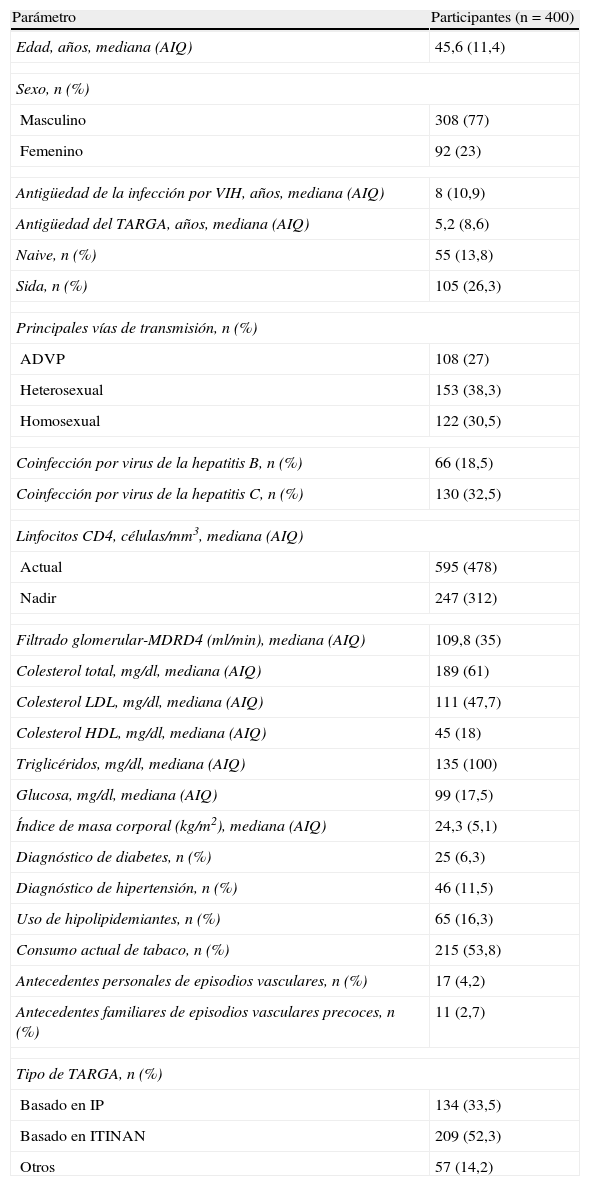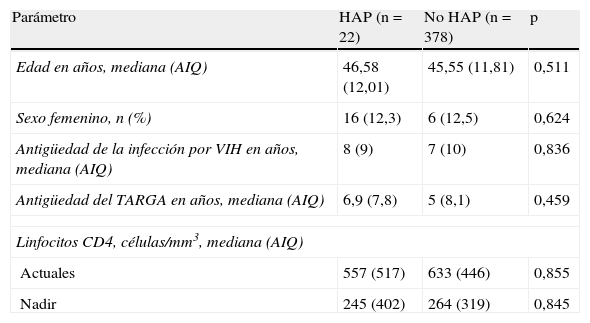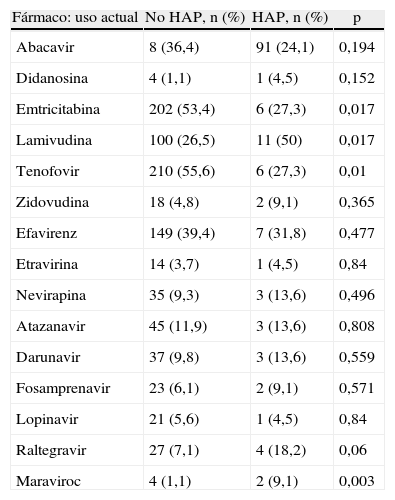La hipertensión arterial pulmonar (HAP) es una enfermedad grave más prevalente en la población con infección por el virus de la inmunodeficiencia humana (VIH). No está claramente establecido el papel que el tratamiento antiretroviral de gran actividad (TARGA) desempeña en su desarrollo. Nuestro objetivo fue describir la prevalencia de HAP en una serie de pacientes con infección por VIH e identificar la relación que pudiera existir con el uso actual y acumulado de antirretrovirales.
Pacientes y métodoEstudio transversal de una cohorte de pacientes con infección por el VIH de un hospital del sur de España. Se recogieron datos demográficos, sobre el estado de la infección VIH y sobre el TARGA actual y acumulado. Se realizó ecocardiografía transtorácica a todos los participantes, definiéndose la HAP como la presencia de una presión sistólica de arteria pulmonar de 36mmHg o más.
ResultadosParticiparon 400 pacientes; 178 presentaban insuficiencia tricuspídea y, de estos, 22 tenían HAP (5,5%). No se observaron diferencias en la edad, el sexo, los linfocitos CD4, la proporción de pacientes naive o con sida, ni en el uso acumulado de antirretrovirales. Sin embargo, el uso reciente de lamivudina se asoció a mayor prevalencia de HAP, y el de emtricitabina y tenofovir a una menor. El análisis de regresión logística se realizó incluyendo el uso actual de estos 3 fármacos. Solo el uso actual de tenofovir se asoció a menor presencia de HAP (odds ratio 0,31; intervalo de confianza del 95% 0,17-0,84).
ConclusionesLa prevalencia de HAP en nuestro estudio es similar a la publicada en el resto de series en pacientes con infección por VIH. El uso actual de tenofovir podría estar asociado con una menor prevalencia de HAP.
Pulmonary arterial hypertension (PAH) is a serious disorder, more prevalent in patients infected with human immunodeficiency virus (HIV). It is not entirely clear what role is played by highly active antiretroviral therapy (HAART) in PAH development or course. Our aim was to describe PAH prevalence in a series of HIV-infected patients and identify possible links with cumulative and current use of different antiretrovirals.
Patients and methodCross-sectional study of a cohort of HIV-infected patients attending a hospital in southern Spain. Demographic data, data on HIV infection status and on cumulative and recent antiretroviral treatment were recorded. Transthoracic echocardiography was performed in all study participants. PAH was defined as pulmonary artery systolic pressure of 36mmHg or more.
ResultsA total of 400 patients participated in the study; 178 presented with tricuspid regurgitation and 22 of these presented with PAH (5.5%). No differences were encountered in age, sex, CD4 lymphocytes, proportion of naive patients or patients with AIDS. No differences were encountered in cumulative use of antiretrovirals. However, recent use of lamivudine was associated with a greater presence of PAH, whereas recent use of tenofovir and emtricitabine was associated with a lower presence of PAH. Logistic regression analysis was performed including the use of lamivudine, emtricitabine and tenofovir. Only recent use of tenofovir was associated with a lower presence of PAH (odds ratio 0.31; 95% confidence interval: 0.17-0.84).
ConclusionsPAH prevalence in our study was similar to others series. Current use of tenofovir may be associated with lower PAH prevalence.
Artículo
Comprando el artículo el PDF del mismo podrá ser descargado
Precio 19,34 €
Comprar ahora









